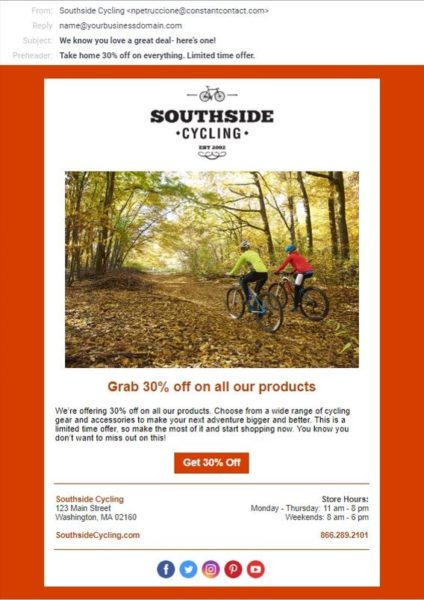
When it comes to writing promotional emails, there’s a fine line between being pushy and annoying, and being convincing and valuable.
No one likes pushy, annoying emails.
Email marketing allows you to send out promotional emails regularly to boost your sales, drive more traffic to your website, and increase brand awareness. Promotional emails refer to emails that are sent out to promote a time-based offer. This could be a discount, coupon code, free download, event, or any other limited-time offer.
These emails can be irritating for the recipient, especially if they’re not tailored to the right audience. Imagine receiving numerous emails about a sale on dog food, when you don’t even own a dog. Similarly, think how would you feel if you got an email from a brand, every single day, promoting an event that is absolutely irrelevant or inaccessible for other reasons.
When you write promotional emails you need to know exactly who you’re writing for. Are your products for women, young working professionals, students, parents, sports enthusiasts, travel enthusiasts, people living in a specific location or of a particular age group? Writing valuable and relevant promotional emails becomes easier when you can picture your customers, and speak to them directly in a way that most appeals to them.
Think before you write
Think about your target customer and then ask the following three questions. The answers will guide you through the email creation process.
What are you offering?
Even before you start outlining your promotional email, think about what you’re offering to your readers. Is it a coupon code that needs to be redeemed, free downloadable content, an event invite, or a gift card? Understanding your offer will help you know what you want your email to say.
How will it benefit your reader?
Once you know who will benefit from your offer, think about how they’ll benefit. Will it help them save money, get rewards or valuable information, or simply get a chance to grab a good deal? For example, if you are offering a free downloadable guide on social media marketing, think about how this guide will help marketers, or small business owners get better at it. Or how would the guide improve their skills and knowledge on social media? You need to figure out the core value of your offer that’ll benefit the readers.
How to grab your offer?
Think about how someone can read your promotional email, and grab your offer. Do they need to click on a link, fill up a form, go to a physical store location, or sign-up for something? For example, if it’s an event you’re promoting you may have an RSVP form that needs to be filled out, but for a sale on your ecommerce website, a customer could just click on a link and reach the right products.
Start writing strong promotional emails
Have you answered all three questions above? Great. Keep those answers top of mind as you write your email copy as they correspond to the different elements of the email: subject line, preheader text, message body, and call-to-action.
Strong subject lines
The subject line of your promotional email is the first thing your customers will see in their inbox. This is your first opportunity to tell the reader what you have to offer. In just about four to seven words you must convince them to go ahead and open the email. You could be direct, create a fear of missing out or tease the reader to heighten curiosity.
Let’s assume you have an online store that offers cycling gear and accessories. You’re running a 30% limited-time sale on all your products and creating promotional emails to send to all your contacts. Here are some subject lines you could use:
Direct subject lines
- Enjoy 30% off on all products
- Shop now to get 30% off on everything
Subject lines to create a fear of missing out
- Hurry! 30% off ending soon
- Last chance to grab 30% off
Subject lines that tease the reader
- We know you love a great deal- here’s one!
- Who doesn’t love a discount?
Subject lines that are direct or create a fear of missing out work well with everyone, however, subject lines that tease the reader work best when a customer recognizes the brand in their inbox and understands the brand’s style of communication. You can A/B test different styles of subject lines to know what works best with your customers.
Informative preheader text
The preheader text is an extension to your subject line. In 6-12 words, you can give more information about what you’re offering, and further increase the chances of a customer opening your email. Think of this as a second, and a longer subject line. The writing style for a pre-header text must always be direct, and informative.
For our cycling sports gears and accessories example, you can pair the preheader text with the subject lines as follows:
- Subject line: Enjoy 30% off on all products
- Preheader: Make the most of our limited time offer
- Subject line: Last chance to grab 30% off
- Preheader: Shop now before the sale ends
- Subject line: Who doesn’t love a discount?
- Preheader: Take home 30% off on everything. Limited time offer.
Powerful Headline
The headline is the first text a reader will see once they open the email. It’s like a ‘topic title’ to your email and is usually a different color or a bigger font than the rest of the email. For a promotional email, the headline must clearly call out the promotion itself.
The headline, like the subject line and preheader text, should answer the question — What are you offering to the reader?
Continuing with our cycling gear and accessories example, the headline could read:
- Enjoy 30% on all products
- 30% off everything
- Grab 30% off on all our products
- Limited time offer: 30% off
Crisp message body
The message body is the biggest piece of text you will write for your promotional email. Try to keep it concise, a paragraph with 4-5 sentences, or add bullet points if there is more information you need to share. This section of your email must convince the reader that the value you’re offering is worth it.
The message body should always answer the question — How will your offer help the reader?
A compelling message body for cycling gear and accessories example could be:
- We’re offering 30% off on all our products. Choose from a wide range of cycling gear and accessories to make your next adventure bigger and better. This is a limited time offer, so make the most of it and start shopping now. You know you don’t want to miss out on this!
- Buy our range of cycling gear and accessories. Shop now to get 30% off on all our products. This limited time offer lets you buy high-quality products at unbelievably low prices. Save big, Buy more!
- Hurry! Our limited time offer ends soon. Get 30% off on all our products. Our sale is on all our cycling gear and accessories. Enjoy low prices, wide variety, and big savings.
Compelling call to action
A call to action or CTA tells the reader what they need to do next. Do you want them to “Shop Now,” “Register Today,”? Tell them exactly what you want them to do to get what your promotional email is offering. You can link to an external source, like a website or a landing page by making your CTA a clickable button that makes the process easier. The call-to-action text must be simple and direct.
The call to action should always answer the question — What should the reader do next?
Taking the sports gear and accessories example, possible call to action texts could be:
- Shop Now
- Buy Now
- Get 30% off
Now, all you need to do is put the final copy into a template for your business. Here’s the finished example for the cycling business:

You can see how all of the elements of the email work together to deliver a compelling message that will drive the reader toward action.
Create promotional emails that drive action
You can create promotional emails that are valuable for your subscribers when you follow some simple guidelines.
Think about who your audience is, what is most important to them and then answer three important questions. Consider what is it that you’re offering, how will it help the reader, and what you want them to do next. If you have all this information thought out in advance, it is easy to move forward and write different sections of your email.
The subject line, preheader text, headline all tell the reader what you have to offer. The message body tells them how they will benefit and the call to action spells out what to do next.
Your promotional emails will be both relevant and valuable when you keep them crisp and strong, driving focus towards the offer, and making it easy for a reader to instantly know what the offer is, why they need it and how they can get it.




